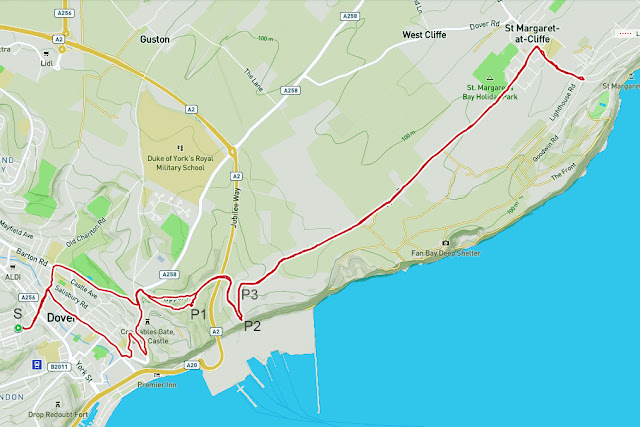The Roman lighthouse is located behind the church on the right. Both structures are Grade I Listed Buildings, as is Dover Castle itself:
Dover Castle is owned by English Heritage and is a scheduled Ancient Monument.
1) The church of St Mary-in-Castro [Note 1]
The latest possible date for the foundation of the church is circa 1020AD.
The exterior is of 2 storeys flint with some reused Roman brick window dressings and some modern ashlar dressings. Modern tiled roof and restored tower.
The Church was roofless and used as a coalstore in the 18th century but was restored for use as a garrison church to the Castle by Sir Gilbert Scott in 1862.
The interior contains a Chancel arch of Roman brick, a blocked Saxon doorway and the site of a Military or soldiers altar of A.D. 1225.
There is a Victorian wooden roof and stained glass windows. Mosaics by Butterfield 1888.
 |
| Garrison school in foreground; Officers New Quarters, Fire Beacon, and English Channel beyond (2011). |
2) The Roman Pharos (lighthouse) [Note 2]
Built in AD 46 under the Emperor Claudius.
This guided the Roman fleet round to the port of Richborough.
In mediaeval (alt. medieval) times it was used as a belfry to the Church of St Mary Sub-Castro.
4 stories, 3 being Roman and the top storey and remains of battlements mediaeval.
An octagonal tower with originally vertical stepped walls rising in tiers set back each within the last, now almost smoothed.
Rubble with a facing of green sandstone and tufa and levelled at an interval of 7 courses with a double course of brick set in hard pink mortar.
Round-headed windows with a small recessed spy-hole inside them.
The location the first photo was taken from is marked "P3" on the cycling route map of 1st April 2020:
Start and end point of cycle ride is the green dot below the "S" near bottom left.
Original map and biometrics at Polar Flow
Abbreviated versions of this post are also on Facebook and Twitter.
More information on this ancient monument: Dover Castle at English Heritage
Permitted cycle ride under the Coronavirus (Covid-19) lockdown rules.
[Note 1] Abridged from St Mary Sub-Castro
[Note 2] Abridged from The Roman Pharos


No comments:
Post a Comment